This news has been a few months in the making, but with the final preparations underway, I feel like it’s time to announce it! In a few weeks, I will be launching my podcast series – Stories from Space – with the Intersection Of Technology, Cybersecurity, And Society Podcast (ITSP), a highly-respected channel that hosts multiple shows. Each of these is dedicated to exploring the past, the present, and the future of humanity’s relationship with technology and the profound effects it can have on our society.
Continue reading “Good News! Stories from Space Picked up by ITSP Magazine!”Category: Space
My First Article for Popular Mechanics!
There’s a potentially Earth-like planet around the closest star to Earth—that’s the space headline that captured the world’s imagination this summer. But here’s something that was easy to forget in all that furor over Proxima Centauri. Our neighboring star doesn’t look anything like the Sun.
We humans have known only one life-sustaining planet in the universe: a green-and-blue globe called Earth. So perhaps we can be forgiven for thinking the ideal ingredients for creating life must resemble what we se here: a bunch of planets around a medium-sized yellow star.
Mind-expanding missions like the Kepler Space Observatory, however, have scientists questioning whether a solar system like ours really is the perfect place to hunt for new Earths and the possibility of life beyond our planet. Lately, astronomers have been taking a closer look at red dwarfs—stars with low mass, low temperatures, and slow rates of fusion.These stars don’t look much like our life-giving Sun, but they make up almost 70 percent of the observable stars in the sky and could survive for trillions of years—far longer than our star.
If we’re going to find life beyond our solar system, many scientists believe it will be orbiting a red dwarf. Here’s why.

The Alien Worlds of Red Dwarfs
In the past, planet-hunters thought the odds of finding potentially habitable worlds around red dwarfs were quite low. Because of their low mass and temperature, red dwarfs emit just 3 percent as much light as our sun. For an orbiting planet not to freeze into an uninhabitable iceball, it would need to be as close to the star as Mercury is to our Sun. Unfortunately, being so close to a star means the planets probably would be tidally locked, where one side is constantly facing the star and the other side always faces away. Not ideal conditions for creating life.
Red dwarfs are also far less stable compared to larger stars, undergoing sudden rises and drops in the amount of light and heat they emit. This creates big variations in temperature, adding yet another challenge for budding life.
If we’re going to find life beyond our solar system, it will likely be orbiting a red dwarf.
It’s not all bad news, though. Red dwarfs have a considerable advantage over other stars in their incredible lifespans. Our Sun has been around for 4.57 billion years, yet humanity has existed for just 200,000 years. Life takes a long time, and complex life even more so.
Time is one thing red dwarfs have plenty of—they can exist for trillions of years because of their low mass and slow rate of nuclear fusion. Since they’re also so common in our cosmos, the odds of finding planets within that habitable Golidlocks zone is statistically high. For astronomers, the pros are starting to outweigh the cons.
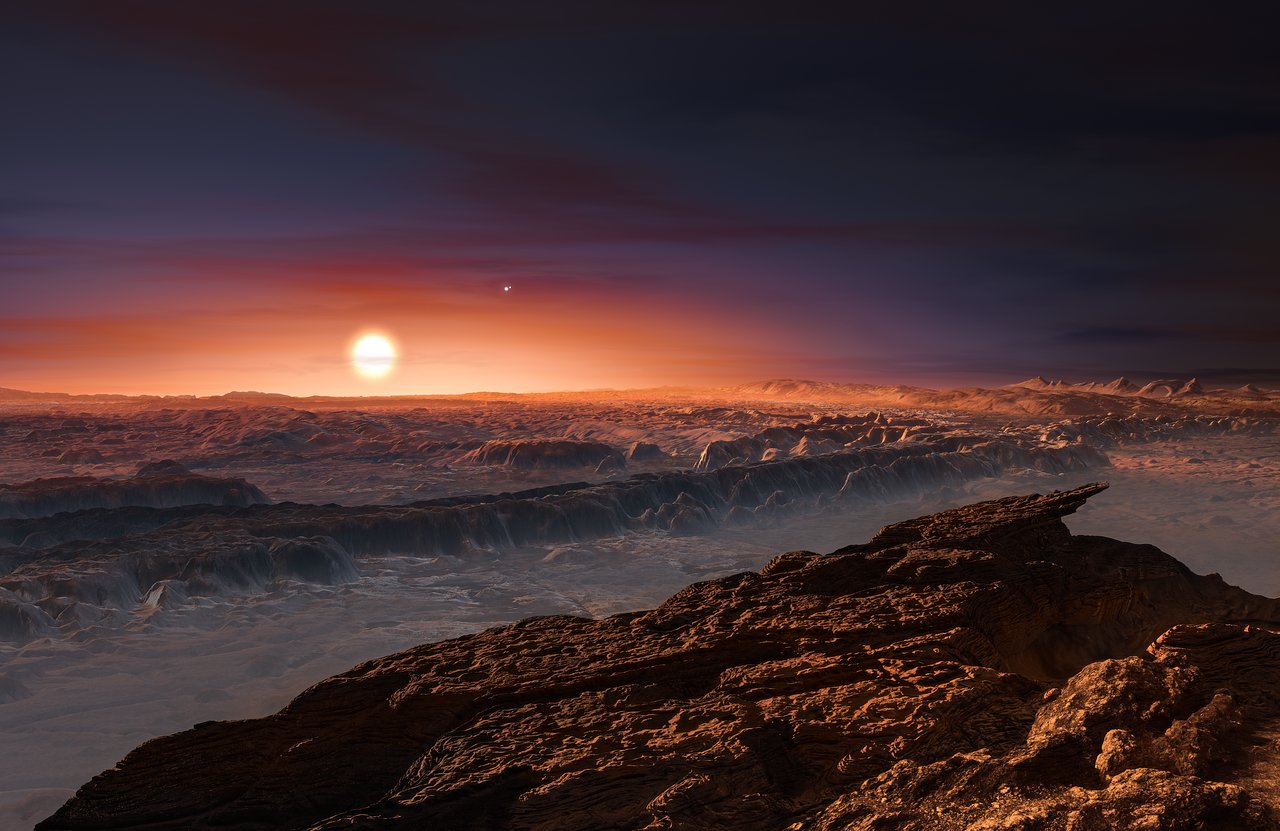
The Case for Going Red
In 2005, astronomers from around the world converged on Mountain View, California, for a workshop sponsored by The Search for Extraterrestrial Intelligence (SETI) where scientists argued the case that red dwarf stars could be the best place to look for aliens. In the end, it comes down to sheer probability. Within 33 light years of Earth there were 240 known red dwarfs at the time, compared to just 21 stars like ours.
Although red dwarfs are hard to find because they’re dim, once they’re spotted it’s much easier to see how many chunks of rock are in orbit. The so-called transit method of finding exoplanets, which the Kepler telescope used to great effect, relies on looking for changes in brightness caused by a planet passing in front of its star. It looks something like this:
Because planets orbiting a red dwarf are likely to hug their stars so tightly, the orbital period is often just a few days long, which makes for pretty good odds of seeing such a transit.
New Worlds Emerge
Since that SETI conference more than a decade ago, oodles of new planets orbiting red dwarfs have been discovered. Between 2005 and 2010, astronomers found six exoplanets orbiting Gliese 581, a red dwarf located about 20 light years from Earth. Two of these planets, Gliese 581-c and -d, lie on the inner and outer edge the star’s habitable zone. Another exoplanet, Gliese 581-g, may also have an orbit fit for habitability (though its existence is still contested).
In 2012, the European Southern Observatory (ESO) published the results of a spectrographic survey that examined 102 red dwarf stars in the Milky Way over the course of six years. They found that red dwarf stars were more likely to have an Earth-like planet orbiting them than a gas giant. Two years later, another ESO study concluded that virtually all red dwarfs in the universe have at least one exoplanet orbiting them. At least a quarter of them have a super-Earth (a planet like ours but slightly bigger) orbiting within their habitable zones.

The drumbeat goes on. This past July, researchers from the Harvard Smithsonian Center for Astrophysics (CfA) released a study in which the team calculated the likelihood of Earth-like planets forming within our universe over cosmic timescales, starting with the first stars to form, billions of years ago, and continuing into the distant future. They determined that low-mass red dwarf stars would be more likely than giant stars to maintain a system of planets long enough for life to emerge, and that likelihood only increased with time.
“We considered the likelihood of ‘life as we know it’ to form between the appearance of the first stars and the death of the last stars,” Professor Avi Loeb, a science professor at Harvard University and the lead author on the paper, told PM. ” We found that the likelihood peaks in the distant future around low-mass stars, simply because these stars live much longer than the Sun.”
Other discoveries made in the past five years have also bolstered the case for habitable planets around red dwarf stars with exoplanet candidates around Innes Star, Kepler 42, Gliese 832, Gliese 667, Gliese 3293, and most recently Proxima Centauri. All of these star systems are located relatively close to our own, though still impossibly out of reach with only today’s space-faring technology.
In the coming years, as more exoplanet hunters like the James Webb Telescope and the Transiting Exoplanet Survey Satellite look to the sky, it’s probable that scientists and astronomers will focus much of their efforts on nearby red dwarf stars.
“One of the great discoveries made in the past decade or so is that it seems like there are planets all over the place,” TESS project scientist Stephen Rinehart told PM, “even around these small stars so different from our own.”
See it here: Popular Mechanics
Wanderers by Erik Wernquist
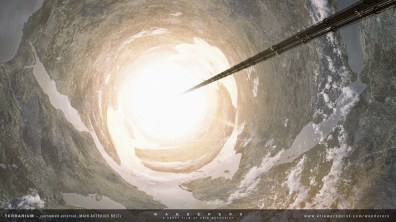
This has to be one of the most inspiring short films of the year. Erik Wernquist = a digital artist and animator from Stockholm, Sweden – released this movie this past fall, and its made quite the impact already! Addressing the idea of future space exploration, Wernquist uses stunning visuals to show how human beings may one day fly to Jupiter, float walk on the surface of Mars, skate on the frozen surfaces of Europa, and fly through the skies of Titan.
One thing I myself loved was the attention to detail and little accuracies. Within each impressive visual, there are hints that give away the locations. For example, the blue sunset is from Mars, as pictured by NASA’s many rover missions over the past few years. The frozen lake where people are skating on shows Jupiter looming in the sky, indicating that it is Europa. And an overhead shot of Titan shows the “Mini Nile River” observed there by the Cassini space probe. And while the asteroid is unnamed, I would bet dollars to donuts that Vesta!
Including in these visuals are a number of speculative science fiction ideas pioneered by writers like Arthur C. Clarke and Kim Stanley Robinson, not the least of which have to do with space elevators and habitats built into hollowed-out asteroids. But above all is the contribution of Carl Sagan, who’s narration from his own book “Pale Blue Dot: A Vision of the Human Future in Space” (1994) provides the voiceover for the film.
You can watch the short film below, and be sure to check out Wernquist’s website for more info and his stunning gallery of images:
Retweeted by NASA and Inside Space!

Good news everyone! After about two months of working for Universe Today, it appears that some of what I say is actually being read by the big names in the bizz! It started three days ago when NASA Earth retweeted an article I wrote entitled “What Percentage of Earth is Water?“, which was part of UT’s Guide to Space section that deals with general knowledge questions about astronomy, geology, the universe, etc.
The second came yesterday when Inside Space retweeted an more recent article I did about the supermassive black hole at the center of our galaxy, and how scientists anticipate that they will be able to view it for the first time in the near future. They were doing a list of the top ten recent news stories of space in recent days, and apparently, my story made the list (I was number 9).
All in all, it’s been a pretty cool week! 🙂
Latest Articles Over At Universe Today!
 As the title would suggest, my third and fourth articles have just been published over at Universe Today. First off, let me assure people that I plan to post a link to UT in the near future so I don’t feel the need to do this every time a new article comes out. But since this is still a new experience to me, I naturally feel the need to share whenever a new one is published.
As the title would suggest, my third and fourth articles have just been published over at Universe Today. First off, let me assure people that I plan to post a link to UT in the near future so I don’t feel the need to do this every time a new article comes out. But since this is still a new experience to me, I naturally feel the need to share whenever a new one is published.
The first of the two, which was published on Monday, deals with a recent determination made about the source of the Moon’s water. This is based on research conducted by scientists over at the National Museum of Natural History in Paris. Back in 2009, India’s Chandrayaa-1 probe conducted a near-infrared survey of the Moon during a flyby that showed signs of surface water.
 After years of speculation that claimed that the surface water – which exists strictly in icy form – was deposited there by meteors and comets, the National Museum team concluded that its actually formed by solar wind interacting with oxygen in the Moon’s surface dust. Quite the odd little occurrence; but then again, even Mercury appears to have icy spots on it’s molten surface.
After years of speculation that claimed that the surface water – which exists strictly in icy form – was deposited there by meteors and comets, the National Museum team concluded that its actually formed by solar wind interacting with oxygen in the Moon’s surface dust. Quite the odd little occurrence; but then again, even Mercury appears to have icy spots on it’s molten surface.
www.universetoday.com/115215/water-on-the-moon-was-blown-in-by-solar-wind/
The second is about a recent collaboration between NASA and SpaceX. While the latter was testing their Falcon 9 rockets, NASA filmed the performance using Infrared cameras. The information gleamed from this is helping SpaceX to develop their reusable rocket, but will also help NASA to figure out how they will land habitats and heavy equipment on the surface of Mars.
 Sort of a win-win scenario, one that shows how the public and private sector are working together like never before to make the future of space exploration happen. And it’s another indication of just how serious NASA and its partners are in making a mission to Mars a reality.
Sort of a win-win scenario, one that shows how the public and private sector are working together like never before to make the future of space exploration happen. And it’s another indication of just how serious NASA and its partners are in making a mission to Mars a reality.
www.universetoday.com/115408/how-nasa-and-spacex-are-working-together-to-land-on-mars/
Feel free to check them out, and stay tuned for the next subject of interest: Dark Matter Emanating From The Sun!
Second Article Published at Universe Today!

Good news! My second article, which deals with the development of deep-space hibernation, just went public over at Universe Today! This one was especially fun to research, since it deals with a subject that is science fiction gold! Whether it’s from 2001: A Space Odyssey, the Alien franchise, Halo, Avatar, or the literature of Alastair Reynolds, the idea of astronauts going into cryogenic suspension has been well-explored over the past few decades.
And now, NASA is collaborating with a private aerospace company called SpaceWorks to research the possibility of using such a procedure when it sends astronauts to Mars and beyond. The advantages are numerous, from cost-cutting to ensuring that astronauts don’t go all nutter-butters during the many, many months (or even years) that it takes to drift through space.
 As seems to be the case more and more these days, researchers and planners are getting serious about it. Much like manned missions to Mars, colonizing Mars, a settlement on the Moon, the Space Elevator, or exploratory missions to Europa, science fiction is fast becoming science fact. Man, am I happy to be alive right now!
As seems to be the case more and more these days, researchers and planners are getting serious about it. Much like manned missions to Mars, colonizing Mars, a settlement on the Moon, the Space Elevator, or exploratory missions to Europa, science fiction is fast becoming science fact. Man, am I happy to be alive right now!
Come and check out the full article at:
www.universetoday.com/115265/nasa-investigating-deep-space-hibernation-technology/
News from Space: We’re Going to Mars!
 As part of their desire to once again conduct launches into space from US soil, NASA recently awarded commercial space contracts worth $6.8 billion to Boeing and SpaceX. But beyond restoring indigenous spaceflight capability, NASA’s long-term aim is clearly getting a manned mission to Mars by 2030. And in assigning the necessary money to the companies and visionaries willing to help make it happen, they just might succeed.
As part of their desire to once again conduct launches into space from US soil, NASA recently awarded commercial space contracts worth $6.8 billion to Boeing and SpaceX. But beyond restoring indigenous spaceflight capability, NASA’s long-term aim is clearly getting a manned mission to Mars by 2030. And in assigning the necessary money to the companies and visionaries willing to help make it happen, they just might succeed.
As per the agreement, Boeing will receive $4.2 billion to finance the completion of the CST-100 spacecraft, and for up to six launches. Meanwhile, SpaceX is receiving $2.6 billion for its manned Dragon V2 capsule, and for up to six launches. NASA expressed excitement its collaboration with both companies, as it frees the agency up for bigger projects — such the development of its own Space Launch System (SLS).
 One person who is sure to be excited about all this is Elon Musk, SpaceX founder, CEO, and private space visionary. With this big infusion of cash, he has apparently decided that it’s time to bring his plans for Mars forward. Ever since 2007, Musk has indicated a desire to see his company mount a manned mission to Mars, and now he may finally have the resources and clout to make it happen.
One person who is sure to be excited about all this is Elon Musk, SpaceX founder, CEO, and private space visionary. With this big infusion of cash, he has apparently decided that it’s time to bring his plans for Mars forward. Ever since 2007, Musk has indicated a desire to see his company mount a manned mission to Mars, and now he may finally have the resources and clout to make it happen.
These plans include flying astronauts to Mars by 2026, almost a decade before NASA thinks it will. By late 2012, he even spoke about building a Mars Colony with a population in the tens of thousands, most likely established sometime during the 2020’s. As of this past year, he has also revealed details about a Mars Colonial Transporter (MCT), an interplanetary taxi that would be capable of ferrying 100 people at a time to the surface.
And then in February of this year, SpaceX began developing the MCT’s engines. Known as the Raptor, this new breed of large engine reportedly has six times the thrust of the Merlin engines that power the second stage of the Falcon 9 rocket. Now that the company has the financial resources to dream big, perhaps the MCT might move from the development stage to prototype creation.
And there is certainly no shortage of desire when it comes to sending people to the Red Planet. Together with Mars Society president Robert Zubrin, and Mars One co-founder Bas Lansdorp, crowdfunded organizations are also on board for a manned mission. The case for settling it, which Musk himself endorses, is a good one – namely, that planting the seed of humanity on other worlds is the best way to ensure its survival.
 And as Musk has stated many times now, a manned mission Mars is the reason there is a SpaceX. Back in 2001, while perusing NASA’s website, he was perturbed to find that the space agency had nothing in the way of plans for a mission to Mars. And the best time to go is probably in about 15 or 20 years, since Mars will be at its closes to Earth by then – some 58 million kilometers (36 million miles).
And as Musk has stated many times now, a manned mission Mars is the reason there is a SpaceX. Back in 2001, while perusing NASA’s website, he was perturbed to find that the space agency had nothing in the way of plans for a mission to Mars. And the best time to go is probably in about 15 or 20 years, since Mars will be at its closes to Earth by then – some 58 million kilometers (36 million miles).
During this window of opportunity, the travel time between Earth and Mars will be measured in terms of months rather than years. This makes it the opportune time to send the first wave of manned spacecraft, be they two-way missions involving research crews, or one-way missions involving permanent settlers. Surprisingly, there’s no shortage of people willing to volunteer for the latter.
 When Mars One posted its signup list for their proposed mission (which is slated for 2025), they quickly drew over 200,000 applicants. And this was in spite of the fact that the most pertinent details, like how they are going to get them there, remained unresolved. Inspiration Mars, which seeks to send a couple on a round trip to Mars by 2021, is similarly receiving plenty of interest despite that they are still years away from figuring out all the angles.
When Mars One posted its signup list for their proposed mission (which is slated for 2025), they quickly drew over 200,000 applicants. And this was in spite of the fact that the most pertinent details, like how they are going to get them there, remained unresolved. Inspiration Mars, which seeks to send a couple on a round trip to Mars by 2021, is similarly receiving plenty of interest despite that they are still years away from figuring out all the angles.
In short, there is no shortage of people or companies eager to send a crewed spaceship to Mars, and federal agencies aren’t the only ones with the resources to dream big anymore. And it seems that the technology is keeping pace with interest and providing the means. With the necessary funding now secured, at least for the time being, it looks like the dream may finally be within our grasp.
Though it has yet to become a reality, it looks like the first Martians will actually come from Earth.
Sources: extremetech.com, (2), sploid.gizmodo.com, mars.nasa.gov
First Article Published at Universe Today!
 Hey all! Just wanted to let people know, my first article for Universe Today just went public. The subject of the article was the Bigelow Expandable Activity Module, a new type of space habitat that is being shipped to the ISS next year. Researching and writing the article itself was not unusual for me. It’s pretty much what I do here every single day. However, the real fun came in speaking to NASA and Bigelow Aerospace themselves via phone and email.
Hey all! Just wanted to let people know, my first article for Universe Today just went public. The subject of the article was the Bigelow Expandable Activity Module, a new type of space habitat that is being shipped to the ISS next year. Researching and writing the article itself was not unusual for me. It’s pretty much what I do here every single day. However, the real fun came in speaking to NASA and Bigelow Aerospace themselves via phone and email.
Interviewing the people behind big ideas and technological innovation is something a humble blogger like myself doesn’t get to do! While I’ve really enjoyed talking to luminaries like Andraka and Makosinski in the past, this was a first for me. Looking forward to doing more of it in the near future!
In any case, follow the link below to check it out and don’t forget to comment and Like us on Facebook… no pressure 😉
News from Space: “Life” Molecules Detected in Space!
 The secret to the creation to life in our universe appears to be seeding – the proper elements in the right mix in the right places to form the right kind of molecules. Only then can these molecules evolve chemically into more and more complex structures, thus following a general pathway toward biology. The pathway for life as we know it starts with carbon, but one which is specific organized and structured.
The secret to the creation to life in our universe appears to be seeding – the proper elements in the right mix in the right places to form the right kind of molecules. Only then can these molecules evolve chemically into more and more complex structures, thus following a general pathway toward biology. The pathway for life as we know it starts with carbon, but one which is specific organized and structured.
Recently, a team of astronomers at the ALMA Observatory reported the discovery of this very element while probing distant galaxies. What they found was not just interstellar carbon, but a form of carbon with a branched structure. The discovery was made in the gaseous-star forming region known as Sagittarius B2 – a giant molecular cloud of gas and dust that is located about 390 light years from the center of the Milky Way.
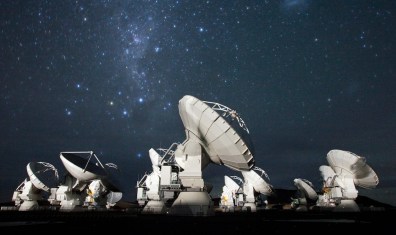 Simple carbon chains aren’t particularly unusual in the cosmos, but complex carbon is a different matter. It is what the researchers, based at Cornell University and the Max Planck Institute, describe as finding a molecular needle in a cosmic haystack. The actual molecule in question is isopropyl cyanide, and it was discerned thanks to the miracle known as radio astronomy.
Simple carbon chains aren’t particularly unusual in the cosmos, but complex carbon is a different matter. It is what the researchers, based at Cornell University and the Max Planck Institute, describe as finding a molecular needle in a cosmic haystack. The actual molecule in question is isopropyl cyanide, and it was discerned thanks to the miracle known as radio astronomy.
Within clouds of interstellar dust and gas, elements find themselves shielded from the harsh radiation of open space and are, thus, free to form into more complex arrangements. These molecules don’t just sit there, but instead move around within their cloud-homes and bump into each other. The result of this activity are radio signals which can be detected light-years away – in this case, by radio telescopes here on Earth.
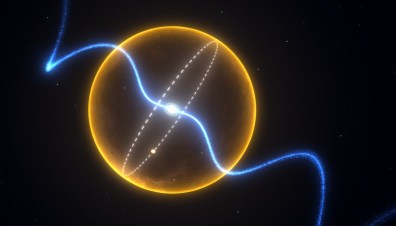 Every molecule has a different radio signal, so it’s possible to pick apart the contents of interstellar junk by examining a cloud’s frequency spectra. NASA, via the Ames Research Center, even maintains a radio-emission frequency database to aid in the tracking of polycyclic aromatic hydrocarbons, a form of molecule thought to contain much of the universe’s carbon stockpiles.
Every molecule has a different radio signal, so it’s possible to pick apart the contents of interstellar junk by examining a cloud’s frequency spectra. NASA, via the Ames Research Center, even maintains a radio-emission frequency database to aid in the tracking of polycyclic aromatic hydrocarbons, a form of molecule thought to contain much of the universe’s carbon stockpiles.
The branching carbon structure of isopropyle cyanide is of particular interest because it’s thought that this arrangement is a step on the way to the production of amino acids, the building blocks of proteins, and hence organic life. The discovery gives weight to the increasingly popular notion that life, or at least many of the key steps leading toward life, actually occurs off-planet.
 Life on Earth may have been well on its way while the planet was still just space dust waiting to come together into our rock-home. What’s more, the molecules discovered by the ALMA team probably aren’t alone. As the authors, led by astronomer Arnaud Belloche, wrote:
Life on Earth may have been well on its way while the planet was still just space dust waiting to come together into our rock-home. What’s more, the molecules discovered by the ALMA team probably aren’t alone. As the authors, led by astronomer Arnaud Belloche, wrote:
[Isopropyle cyanide’s] detection therefore bodes well for the presence in the [interstellar medium] (ISM) of amino acids, for which such side-chain structure is a key characteristic… This detection suggests that branched carbon-chain molecules may be generally abundant in the [interstellar medium].
The discovery follows a general progression in recent years adding more and more life-ingredients to our picture of the ISM. A 2011 study revealed that complex organic matter should be created in large volumes from stars, while a 2012 report study found that conditions within the ISM are uniquely suited to the creation of increasingly complex molecules, “step[s] along the path toward amino acids and nucleotides, the raw materials of proteins and DNA, respectively.”
 Also in 2012, astronomers working for ALMA found basic sugar molecules hanging out in the gas cloud around IRAS 16293-2422 – a young star located some 400 light-years from Earth. The particular form, glycoaldehyde, is thought to be a key component of the reaction behind the creation of DNA. Indeed, more and more, the universe is looking less and less like a harsh environment in which life must struggle to emerge, to a life factory.
Also in 2012, astronomers working for ALMA found basic sugar molecules hanging out in the gas cloud around IRAS 16293-2422 – a young star located some 400 light-years from Earth. The particular form, glycoaldehyde, is thought to be a key component of the reaction behind the creation of DNA. Indeed, more and more, the universe is looking less and less like a harsh environment in which life must struggle to emerge, to a life factory.
Source: motherboard.vice.com
The Future of Space: A Space Elevator by 2050?
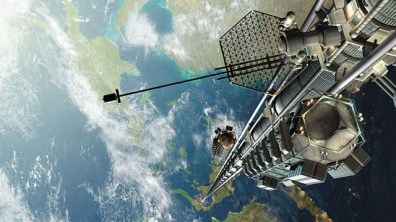 In the ongoing effort to ensure humanity has a future offworld, it seems that another major company has thrown its hat into the ring. This time, its the Japanese construction giant Obayashi that’s declared its interest in building a Space Elevator, a feat which it plans to have it up and running by the year 2050. If successful, it would make space travel easier and more accessible, and revolutionize the world economy.
In the ongoing effort to ensure humanity has a future offworld, it seems that another major company has thrown its hat into the ring. This time, its the Japanese construction giant Obayashi that’s declared its interest in building a Space Elevator, a feat which it plans to have it up and running by the year 2050. If successful, it would make space travel easier and more accessible, and revolutionize the world economy.
This is just the latest proposal to build an elevator in the coming decades, using both existing and emerging technology. Obayashi’s plan calls for a tether that will reach 96,000 kilometers into space, with robotic cars powered by magnetic linear motors that will carry people and cargo to a newly-built space station. The estimated travel time will take 7 days, and will cost a fraction of what it currently takes to bring people to the ISS using rockets.
 The company said the fantasy can now become a reality because of the development of carbon nanotechnology. As Yoji Ishikawa, a research and development manager at Obayashi, explained:
The company said the fantasy can now become a reality because of the development of carbon nanotechnology. As Yoji Ishikawa, a research and development manager at Obayashi, explained:
The tensile strength is almost a hundred times stronger than steel cable so it’s possible. Right now we can’t make the cable long enough. We can only make 3-centimetre-long nanotubes but we need much more… we think by 2030 we’ll be able to do it.
Once considered the realm of science fiction, the concept is fast becoming a possibility. A major international study in 2012 concluded the space elevator was feasible, but best achieved with international co-operation. Since that time, Universities all over Japan have been working on the engineering problems, and every year they hold competitions to share their suggestions and learn from each other.
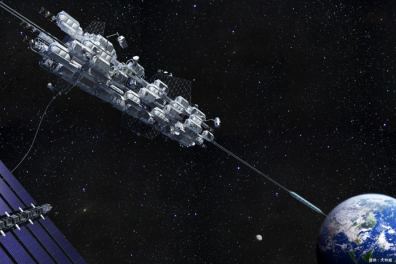 Experts have claimed the space elevator could signal the end of Earth-based rockets which are hugely expensive and dangerous. Compared to space shuttles, which cost about $22,000 per kilogram to take cargo into space, the Space Elevator can do it for around $200. It’s also believed that having one operational could help solve the world’s power problems by delivering huge amounts of solar power. It would also be a boon for space tourism.
Experts have claimed the space elevator could signal the end of Earth-based rockets which are hugely expensive and dangerous. Compared to space shuttles, which cost about $22,000 per kilogram to take cargo into space, the Space Elevator can do it for around $200. It’s also believed that having one operational could help solve the world’s power problems by delivering huge amounts of solar power. It would also be a boon for space tourism.
Constructing the Space Elevator would allow small rockets to be housed and launched from stations in space without the need for massive amounts of fuel required to break the Earth’s gravitational pull. Obayashi is working on cars that will carry 30 people up the elevator, so it may not be too long before the Moon is the next must-see tourist destination. They are joined by a team at Kanagawa University that have been working on robotic cars or climbers.
 And one of the greatest issues – the development of a tether that can withstand the weight and tension of stresses of reaching into orbit – may be closer to being solved than previously thought. While the development of carbon nanotubes has certainly been a shot in the arm for those contemplating the space elevator’s tether, this material is not quite strong enough to do the job itself.
And one of the greatest issues – the development of a tether that can withstand the weight and tension of stresses of reaching into orbit – may be closer to being solved than previously thought. While the development of carbon nanotubes has certainly been a shot in the arm for those contemplating the space elevator’s tether, this material is not quite strong enough to do the job itself.
Luckily, a team working out of Penn State University have created something that just might. Led by chemistry professor John Badding, the team has created a “diamond nanothread” – a thread composed of carbon atoms that measures one-twenty-thousands the diameter of a single strand of human hair, and which may prove to be the strongest man-made material in the universe.
 At the heart of the thread is a never-before-seen structure resembling the hexagonal rings of bonded carbon atoms that make up diamonds, the hardest known mineral in existence. That makes these nanothreads potentially stronger and more resilient than the most advanced carbon nanotubes, which are similar super-durable and super-light structures composed of rolled up, one atom-thick sheets of carbon called graphene.
At the heart of the thread is a never-before-seen structure resembling the hexagonal rings of bonded carbon atoms that make up diamonds, the hardest known mineral in existence. That makes these nanothreads potentially stronger and more resilient than the most advanced carbon nanotubes, which are similar super-durable and super-light structures composed of rolled up, one atom-thick sheets of carbon called graphene.
Graphene and carbon nanotubes are already ushering in stunning advancements in the fields of electronics, energy storage and even medicine. This new discovery of diamond nanothreads, if they prove to be stronger than existing materials, could accelerate this process even further and revolutionize the development of electronics vehicles, batteries, touchscreens, solar cells, and nanocomposities.
 But by far the most ambitious possibility offered is that of a durable cable that could send humans to space without the need of rockets. As John Badding said in a statement:
But by far the most ambitious possibility offered is that of a durable cable that could send humans to space without the need of rockets. As John Badding said in a statement:
One of our wildest dreams for the nanomaterials we are developing is that they could be used to make the super-strong, lightweight cables that would make possible the construction of a ‘space elevator’ which so far has existed only as a science-fiction idea,
At this juncture, and given the immense cost and international commitment required to built it, 2050 seems like a reasonable estimate for creating a Space Elevator. However, other groups hope to see this goal become a reality sooner. The International Academy of Astronautics (IAA) for example, thinks one could be built by 2035 using existing technology. And several assessments indicate that a Lunar Elevator would be far more feasible in the meantime.
Come what may, it is clear that the future of space exploration will require us to think bigger and bolder if we’re going to secure our future as a “space-faring” race. And be sure to check out these videos from Penn State and the Obayashi Corp:
John Badding and the Nanodiamond Thread:
Obayashi and the 2050 Space Elevator:
Sources: cnet.com, abc.net.au, science.psu.edu


